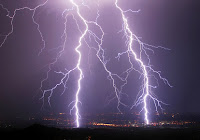 While summer can be a time for relaxation and vacationing,
it often brings thunderstorms and lightning, which can do more damage than
simply taking the fun out of outdoor activities. In 2010, there were 29
fatalities and 182 injuries from lightning in the U.S.
While summer can be a time for relaxation and vacationing,
it often brings thunderstorms and lightning, which can do more damage than
simply taking the fun out of outdoor activities. In 2010, there were 29
fatalities and 182 injuries from lightning in the U.S.
To help prepare for dangerous storms, FEMA offers the
following tips:
- Build an emergency kit and compile a family communications plan.
- Postpone outdoor activities if a storm is predicted.
- Remove dead trees and branches that could fall during strong winds.
- If after seeing lightning, you cannot count to 30 before hearing thunder, go indoors immediately.
- Secure any large outdoor objects that could cause damage if blown out of place.
- Seek shelter inside sturdy buildings or hard top automobiles (not convertibles).
- Avoid contact with anything metal during the storm, including metal parts of the car you have sought shelter in. Contrary to common beliefs, rubber tires do not protect against lightning strikes.
- Secure outside doors and shutter windows, if possible. For windows without shutters, close blinds, shades or curtains.
- Unplug electronic equipment before the storm begins and refrain from touching electrical devices and corded phones during the storm.
- Avoid contact with sinks, showers and other plumbing fixtures during the storm because they can conduct electricity.
